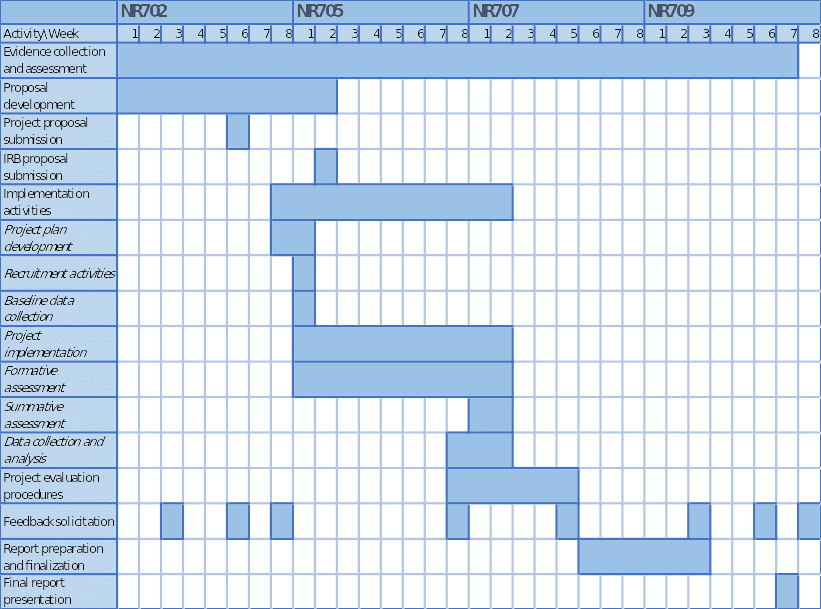
At the completion of the project (week ten, timeframe), all the adopted quality indicators suggested by National Institute for Health and Care Excellence [NICE] (2016b) will experience at least a twenty-percent improvement (specific, realistic, achievable) as evidenced by the depression case management documentation (measurable).
The first objective can be supplemented by the following long-term objective.
At the completion of the project (week ten, timeframe), the must-do quality indicators suggested by NICE (2016b) will achieve 100% (specific, realistic, achievable) as evidenced by the depression case management documentation (measurable).
The must-do aspects include, for instance, proper assessment procedures, the revision of treatment for resistant cases, and so on.
Short-term objectives are the following ones.
- During the first week of the project (timeframe), 100% of the nurses will review and understand the new guidelines as evidenced by their reports during the discussion of the first week (specific, realistic, achievable, and measurable).
- At the beginning of the second week of the project (timeframe), 100% of the nurses will be using the new standards (specific, realistic, achievable) as evidenced by their use of depression case management documentation (measurable).
- By the fifth week of the project (timeframe), at least 50% of the nurses’ reported concerns and difficulties will be addressed (specific, realistic, achievable) as evidenced by the discussion documentation (measurable).
Additional goals may be introduced by the principal investigator in collaboration with the nurses.
Risks and Unintended Consequences
The project aims to improve the quality of care, but it is acknowledged that this outcome may be not achieved. Thus, the unintended consequence of the project is the lack of improvement. Moreover, the change is a complex process, which might cause short-term confusion and decrease in the quality of care. Also, the change might put additional pressure on nurses, which may also affect their productivity in a negative way and, possibly, discourage them from employing the new methods. All the stress-related risks and unintended consequences are going to be mitigated with the help of active communication.
Change Model
The project will employ the change model by Rogers, which can be successfully merged with the previously selected Iowa model (Hanrahan et al., 2015). The five stages of the approach are focused on the engagement of individual stakeholders, which is an important basis for organizational change: technically, the latter depends on the former (Pashaeypoor, Ashktorab, Rassouli, & Alavi-Majd, 2016).
Moreover, the theory also discusses the innovation properties, the determination and management of which can help the stakeholders in the process of adoption (Hanrahan et al., 2015). For instance, determining that a change is viewed as too complex should prompt additional educational efforts, which can change this perception. Overall, the theory promotes sustainable change, and its emphasis on the individual adoption processes will help to address nurses’ concerns and difficulties.
DNP Project Timeline Example
The figure below presents the proposed DNP project timeline. The “feedback” element refers to the feedback on the project; the feedback from nurses on the intervention is a part of formative assessment. The specific implementation activities are highlighted in italics; the implementation of the intervention will include all the elements proposed by the change model.

Resources
Human resource (time and effort) is crucial for the project. The participants are not going to be motivated by money; rather, they will be provided with a chance for improving their practice as an incentive. However, the statistician will be hired: the University of Florida Department of Biostatistics (n.d.) presents its fee rates, which can be used to calculate the expected payment. Other than the statistician’s assistance, no services are expected to be used.
The evidence review requires the access to research articles and books, which is obtained by the principal investigator. The implementation process is going to need some supplies, equipment, and space. NICE (2016a) provides change enabling tools, including flowcharts and guides. These materials are freely available, but some of them may need to be printed for convenient use, and this aspect of future expenses appears in the “supplies” field of the budget. Also, the project will be employing the equipment and software that is already available at the center (for instance, computers). No financial support is offered by VEGA, but it will accommodate the training and discussion and provide nurses with time off for the sessions if needed. The summary of resulting expenses is presented below.
Budget
| Expenses | Achieve academic excellence with our professional dissertation writing services, offering personalized support and expert guidance to help you create a standout thesis with confidence.
|